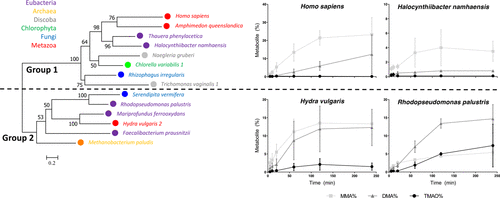当前位置:
X-MOL 学术
›
Chem. Res. Toxicol.
›
论文详情
Our official English website, www.x-mol.net, welcomes your
feedback! (Note: you will need to create a separate account there.)
Predicted AS3MT Proteins Methylate Arsenic and Support Two Major Phylogenetic AS3MT Groups
Chemical Research in Toxicology ( IF 3.7 ) Pub Date : 2020-11-06 , DOI: 10.1021/acs.chemrestox.0c00375 Jesper Torbøl Pedersen 1, 2 , Jessica De Loma 2 , Michael Levi 2 , Michael Palmgren 1 , Karin Broberg 1, 2
Chemical Research in Toxicology ( IF 3.7 ) Pub Date : 2020-11-06 , DOI: 10.1021/acs.chemrestox.0c00375 Jesper Torbøl Pedersen 1, 2 , Jessica De Loma 2 , Michael Levi 2 , Michael Palmgren 1 , Karin Broberg 1, 2
Affiliation

|
Inorganic arsenic is one of the most toxic and carcinogenic substances in the environment, but many organisms, including humans, methylate inorganic arsenic to mono-, di-, and trimethylated arsenic metabolites, which the organism can excrete. In humans and other eukaryotic organisms, the arsenite methyltransferase (AS3MT) protein methylates arsenite. AS3MT sequences from eukaryotic organisms group phylogenetically with predicted eubacterial AS3MT sequences, which has led to the suggestion that AS3MT was acquired from eubacteria by multiple events of horizontal gene transfer. In this study, we evaluated whether 55 (out of which 47 were predicted based on protein sequence similarity) sequences encoding putative AS3MT orthologues in 47 species from different kingdoms can indeed methylate arsenic. Fifty-three of the proteins showed arsenic methylating capacity. For example, the predicted AS3MT of the human gut bacterium Faecalibacterium prausnitzii methylated arsenic efficiently. We performed a kinetic analysis of 14 AS3MT proteins representing two phylogenetically distinct clades (Group 1 and 2) that each contain both eubacterial and eukaryotic sequences. We found that animal and bacterial AS3MTs in Group 1 rarely produce trimethylated arsenic, whereas Hydra vulgaris and the bacterium Rhodopseudomonas palustris in Group 2 produce trimethylated arsenic metabolites. These findings suggest that animals during evolution have acquired different arsenic methylating phenotypes from different bacteria. Further, it shows that humans carry two bacterial systems for arsenic methylation: one bacterium-derived AS3MT from Group 1 incorporated in the human genome and one from Group 2 in F. prausnitzii present in the gut microbiome.
中文翻译:

预测的 AS3MT 蛋白质甲基化砷并支持两个主要的系统发育 AS3MT 组
无机砷是环境中毒性最强、致癌性最强的物质之一,但包括人类在内的许多生物体将无机砷甲基化为单甲基化、二甲基化和三甲基化砷的代谢物,生物体可以将其排出体外。在人类和其他真核生物中,亚砷酸盐甲基转移酶 (AS3MT) 蛋白甲基化亚砷酸盐。来自真核生物的 AS3MT 序列在系统发育上与预测的真细菌 AS3MT 序列分组,这导致提出 AS3MT 是通过多个水平基因转移事件从真细菌中获得的。在这项研究中,我们评估了 55 个(其中 47 个是根据蛋白质序列相似性预测的)编码来自不同界 47 个物种的推定 AS3MT 直向同源物的序列是否确实可以甲基化砷。53 种蛋白质显示出砷甲基化能力。例如,人类肠道细菌的预测 AS3MTFaecalibacterium prausnitzii有效地甲基化砷。我们对代表两个系统发育不同进化枝(第 1 组和第 2 组)的 14 种 AS3MT 蛋白进行了动力学分析,每个进化枝都包含真细菌和真核生物序列。我们发现第 1 组中的动物和细菌 AS3MT 很少产生三甲基化砷,而第 2 组中的Hydra vulgaris和细菌沼泽红假单胞菌产生三甲基化砷代谢物。这些发现表明,进化过程中的动物从不同的细菌中获得了不同的砷甲基化表型。此外,它表明人类携带两种用于砷甲基化的细菌系统:一种来自细菌来源的 AS3MT,来自第 1 组并入人类基因组,另一种来自第 2 组F. prausnitzii存在于肠道微生物群中。
更新日期:2020-12-21
中文翻译:

预测的 AS3MT 蛋白质甲基化砷并支持两个主要的系统发育 AS3MT 组
无机砷是环境中毒性最强、致癌性最强的物质之一,但包括人类在内的许多生物体将无机砷甲基化为单甲基化、二甲基化和三甲基化砷的代谢物,生物体可以将其排出体外。在人类和其他真核生物中,亚砷酸盐甲基转移酶 (AS3MT) 蛋白甲基化亚砷酸盐。来自真核生物的 AS3MT 序列在系统发育上与预测的真细菌 AS3MT 序列分组,这导致提出 AS3MT 是通过多个水平基因转移事件从真细菌中获得的。在这项研究中,我们评估了 55 个(其中 47 个是根据蛋白质序列相似性预测的)编码来自不同界 47 个物种的推定 AS3MT 直向同源物的序列是否确实可以甲基化砷。53 种蛋白质显示出砷甲基化能力。例如,人类肠道细菌的预测 AS3MTFaecalibacterium prausnitzii有效地甲基化砷。我们对代表两个系统发育不同进化枝(第 1 组和第 2 组)的 14 种 AS3MT 蛋白进行了动力学分析,每个进化枝都包含真细菌和真核生物序列。我们发现第 1 组中的动物和细菌 AS3MT 很少产生三甲基化砷,而第 2 组中的Hydra vulgaris和细菌沼泽红假单胞菌产生三甲基化砷代谢物。这些发现表明,进化过程中的动物从不同的细菌中获得了不同的砷甲基化表型。此外,它表明人类携带两种用于砷甲基化的细菌系统:一种来自细菌来源的 AS3MT,来自第 1 组并入人类基因组,另一种来自第 2 组F. prausnitzii存在于肠道微生物群中。











































 京公网安备 11010802027423号
京公网安备 11010802027423号